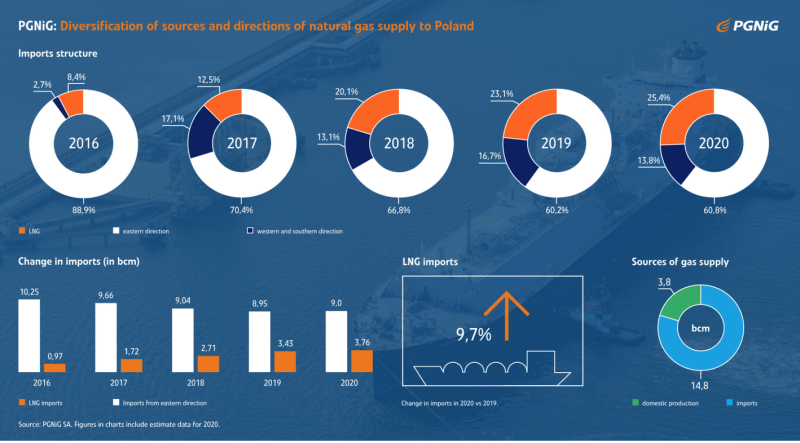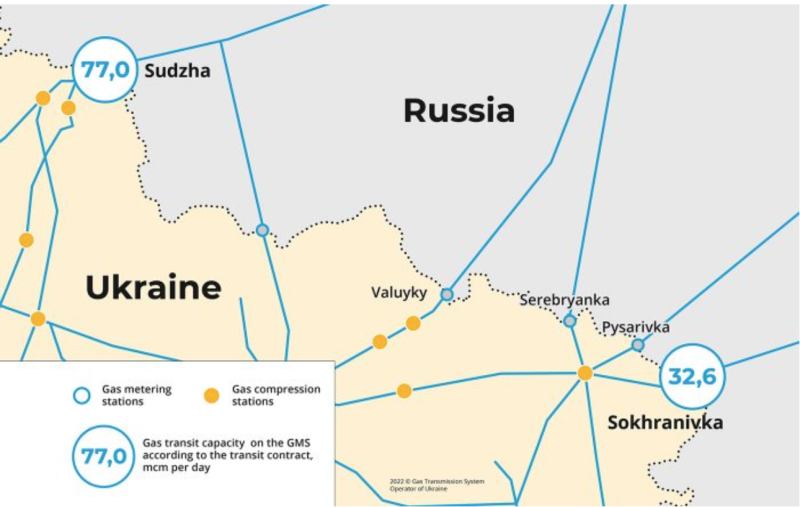Sempra Infrastructure and Poland’s state-owned PGNiG oil and gas company inked a deal Monday, 16 May, that is expected to lead to a final 20-year sale and purchase agreement for the export of 3 mtpa of liquified natural gas (LNG) to Poland.
The two companies have signed a Heads of Agreement (HOA) with intent to finalize a sales and purchase contract for sourcing 2 mtpa from the Cameron LNG expansion terminal in Louisiana and 1 mtpa from the anticipated Port Arthur LNG terminal in Texas, according to news releases issued by the companies.
Poland will receive the LNG at a floating regasification terminal in the Gulf of Gdansk; total yearly volume of LNG would represent approximately 4 Bcm of natural gas after regasification, Sempra said, predicting that deliveries could start in 2027 and be priced on an FOB basis (free on board, meaning the buyer assumes all transport costs).
Monday’s announcement comes 2 weeks after Russia shut off the gas it has been supplying to Poland and to Bulgaria after both countries refused to pay for deliveries in rubles as required by new contract terms imposed unilaterally by the Kremlin.
Russia’s contracts with Poland and Bulgaria are set to expire this year and both countries have said they will not renew.

Poland’s restructuring of gas imports 2016–2020. Source: PGNiG
Only last week (Tuesday, 10 May) Ukraine’s Gas Transmission System Operator (GTSOU) declared force majeure, causing a temporary suspension of Russian gas flows to Europe that spotlighted yet again the challenges Europe faces in ensuring its near-term energy security as it struggles with the fact that it cannot end its dependence on Russian gas overnight.
Ukraine had said it had no choice but to declare force majeure after Russian troops shut off the pipeline operator’s access to the Sokhranivka gas metering station and the border compressor station at Novopskov, facilities located in the Russian-occupied Luhansk region in the eastern part of the country known as Donbas.
On the next day, Russian gas flows transiting Ukraine dropped 25%.
A statement posted on the GTSOU website said Russian forces had interfered with “technical processes and changes in the modes of operation of GTS facilities, including unauthorized gas offtakes from the gas transit flows, [that] endangered the stability and safety of the entire Ukrainian gas transportation system.”
Thus, Ukraine could not “fulfill its obligations” because it does not “control the affected gas metering and compressor stations,” and so it had “no choice but to invoke force majeure,” the statement concluded.
Ukraine had proposed rerouting Russian transit gas through the Ukrainian-controlled Sudzha metering station in the Sumy region northwest of the city of Kharkiv, its second point of entry and the larger of the two; but Russia refused, saying it could not be done technically even though larger gas volumes were rerouted successfully in 2020 via Sudzha during maintenance work.
As of Saturday (14 May) however, Yuriy Vitrenko, CEO of Ukraine’s gas company Naftogas, told Bloomberg television in a live interview that transit volumes to Europe had been restored and that repairs were being made to domestic gas delivery infrastructure in the Kharkiv region.
The same day, GTSOU noted on its website that 54 gas distribution stations for domestic customers in seven regions of Ukraine remained shut down because of hostilities.
Russia Required To “Pump or Pay” for Ukrainian Transit
At the end of 2019, Russia and Ukraine signed a 5-year contract which, at the time, Radio Liberty reported was worth $7 billion in transit fees to Ukraine. The contract required Ukraine to ship a minimum of 65 billion m3 of Russian gas to Europe annually, although minimum volumes were to gradually decrease to 40 billion m3 by 2024.
The agreement includes a "pump or pay" clause, requiring Russia to pay the minimum gas-transit fee even if it fails to export any gas via Ukraine.
Russia’s Gazprom said it is still shipping gas to Europe via Ukraine despite the military conflict, but volumes fell to 72 million m3 on 11 May, compared to 95.8 million m3 the day previously because of the problems at the Lukhansk border crossing, Reuters reported.

Location of gas metering stations on Ukraine’s eastern border with Russia. Source: Gas Transmission System Operator of Ukraine.
Nearly a third of Russian gas flows to Europe transits Ukraine (up to 32.6 m3/D, most of it bound for Austria, Italy, Slovakia, and other East European states.
Europe also imports Russian gas that transits Poland from the Yamal-Europe pipeline which Warsaw has been seeking to make irrelevant for many years now and is now seeing its efforts bear fruit.
Poland’s President Lech Kaczyński's LNG Terminal in Świnoujście became operational in 2016 and is now expanding its regasification capacity to 7.5 billion m3 per year from the current 5.0 billion m3.
In addition, the facility is installing a third LNG storage tank of 180,000 m3, upgrading its LNG-to-rail-transshipment capability, and constructing a second jetty for loading, unloading, and bunkering of LNG, according to its operator Gaz-System.
On 1 May, Poland also commissioned the GIPL (Gas Interconnection Poland-Lithuania) which links Warsaw’s LNG facilities to those in Kliepeda in Lithuania.
As for pipelines, Poland will begin importing Norwegian gas via the Baltic Pipeline from Norway’s sector of the North Sea with expectations of reaching full capacity of 10 billion m3 per year in January, according to the project’s website. Warsaw also expects to bring new interconnections online, one with Germany (1.5 billion m3 per year and another with Slovakia that will become operational in summer (5.0 to 6.0 billion m3 per year), according to Gaz-System.


